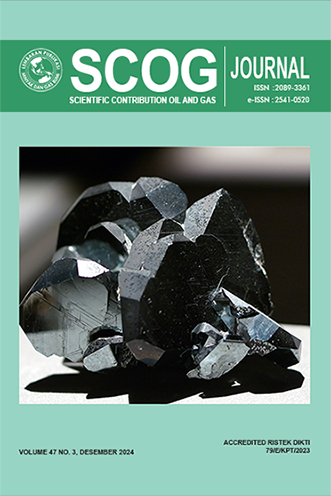Risk-Based Inspection Analysis of Api 581 Pressure Safety Valve & Stripper Acid Gas Removal Unit at PT XY
DOI:
https://doi.org/10.29017/SCOG.47.3.1645Keywords:
RBI, POF, COF, risk analysis, inspection schedulingAbstract
The process involving the stripper equipment in the Amine Gas Recovery Unit (AGRU), which separates rich amine, is a crucial part of the natural gas purification system. The use of a pressure safety valve is essential to maintaining operational safety. Long-term mechanical damage can lead to equipment failures such as leaks, fires, and poisoning, negatively impacting production efficiency and personnel safety. Risk-Based Inspection (RBI) is a method for inspecting, preventing, and controlling incident risks through mathematical inspections related to Probability of Failure (POF) Analysis, Consequence of Failure (COF) Analysis, and Risk Evaluation, with the output being an inspection schedule. The study results include the probability of overpressure under fire scenarios (2,82504 x 10-08), overfilling (7,06261 x 10-07), failure to open (1,49 x 10-05), and leak (3,64 x 10-02), with the consequence category averaging E, indicating that the Matrik Risiko from these scenarios is high risk. The inspection schedule is set every four years because the remaining life is half the project duration, warranting inspections at a maximum interval of 10 years. This four-year interval is based on the regulations from the Ministry of Energy and Mineral Resources No. 38 of 2017. Operational conditions, such as frequent foaming in the AGRU influence it.
References
American Petroleum Institute. (2016). Risk-based Inspection Methodology API RECOMMENDED PRACTICE 581 THIRD EDITION,.
DIREKTORAT JENDERAL MINYAK DAN GAS BUMI. (2020). ZERO Unplanned Shutdown ZERO FATALITY. 3.
DYAH ARINA WAHYU L. (2016). REMAINING LIFE ASSESSMENT AND INSPECTION PLANNING FOR PRESSURE VESSEL USING RISK BASED INSPECTION METHOD (RBI)" Institut Teknologi Sepuluh Nopember Surabaya.
Haugen, S., Barros, A., Gulijk, C. van, Kongsvik, T., & Vinnem, J. E. (n.d.). Safety and reliability : safe societies in a changing world : proceedings of the 28th international European Safety and Reliability Conference (ESREL 2018), Trondheim, Norway, 17-21 June 2018.
HENDRIYA BINAWA GANA. (2015). RISK ASSESSMENT PADA UNIT MENGGUNAKAN METODE RISK BASED INSPECTION API 581 RISK ASSESSMENT ON UNIT SEPARATOR OF EXCESS NH 3 AND DECOMPOSER OF AMMONIUM CARBAMATE USING RISK BASED.
Institute, A. P. (n.d.). API 580-Risk-Based Inspection.
Ir, D. M. (1983). Built in Maontenance (Dalam Refinery). Lembar Publik LEMIGAS, 1 of 13.
Ir Dwi Priyanta, S., & Dhimas Widhi, M. H. (2016). REMAINING LIFE ASSESSMENT AND INSPECTION PLANNING FOR PRESSURE VESSEL USING RISK BASED INSPECTION METHOD (RBI) DYAH ARINA WAHYU L.
Lusyana, L., & Atmanto, M. D. (2022). Risks Analysis Of Carbon Dioxide Storage In Geological Formations. Scientific Contributions Oil and Gas, 34(2), 117–126. https://doi.org/10.29017/scog.34.2.798
Petroleum Institute, A. (2006). API 510 (2006): Pressure Vessel Inspection Code: In-Service Inspection, Rating, Repair, and Alteration.
Qathafi, M. A., & Sulistijono. (2015). Studi Aplikasi Metode RBI semi-Kuatitatif API 581 pada Production Separator. Jurnal Teknik ITS, 4(1), 89–94.
Saifulloh, M. (2018). “analisis penjadwalan program inspeksi.†Jurnal Ilmiah.
Soelaiman, F., Taufik, A., & Soma, T. A. (2004). Jurnal Teknik Mesin Volume XIX - No . 2 - Oktober 2004. Jurnal Teknik Mesin, XIX(2).
Downloads
Published
Issue
Section
License
Copyright (c) 2024 SCIENTIFIC CONTRIBUTIONS OIL AND GAS (SCOG)

This work is licensed under a Creative Commons Attribution 4.0 International License.
Authors are free to Share — copy and redistribute the material in any medium or format for any purpose, even commercially Adapt — remix, transform, and build upon the material for any purpose, even commercially.
The licensor cannot revoke these freedoms as long as you follow the license terms, under the following terms Attribution — You must give appropriate credit , provide a link to the license, and indicate if changes were made . You may do so in any reasonable manner, but not in any way that suggests the licensor endorses you or your use.
No additional restrictions — You may not apply legal terms or technological measures that legally restrict others from doing anything the license permits.














